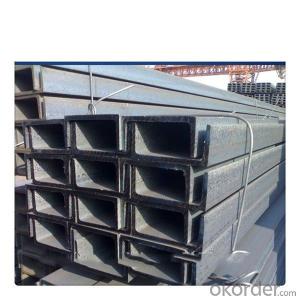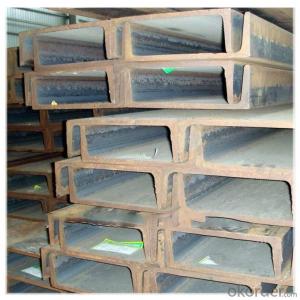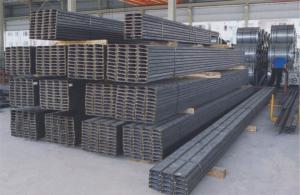Height 70mm the Thickness 8mm Surface and Length: according to the requirements of Channel Stee
- Loading Port:
- Qingdao
- Payment Terms:
- TT OR LC
- Min Order Qty:
- 15 m.t.
- Supply Capability:
- 500000 m.t./month
OKorder Service Pledge
OKorder Financial Service
You Might Also Like
U Channel Steel the Length Thickness According to the Customer
1、the details information of our Channel Steel
1)the ordinary model
Height: | 70-400mm |
Thickness: | 9-14.5mm |
Surface: | according to the customers’ requirements |
Length: | As customers’ requirements |
Size: | 90*37*4.5mm--400*104*14.5 mm . |
Punch: | Can be punched as customer's drawing |
Material: | Q195/Q235/ Q215/Q345/SS400/S235JR, A36,SS400,SS540 ASTM A36 and so on |
2)the light model
Height: | 70-400mm |
Thickness: | 6.4-8.0mm |
Surface: | Painted or Galvanized;according to the customers’ requirements |
Length: | As customers’ requirements |
Size: | 50*32*4.4mm--400*115*8.0mm . |
Punch: | Can be punched as customer's drawing |
Material: | Q195/Q235/ Q215/Q345/SS400/S235JR, A36,SS400,SS540 ASTM A36 and so on |
2、the Product Advantage
1) We can design the channel steel according to customers’requirements
2) We can manufacture under complete quality control system---ISO9001&SGS
3) We can installed with instruction of experienced engineers
4) Easy to assemble and dismantle
5) Eco-friendly material: can be used for several times and can be recycled
6) Shorter construction period, longer using time
7) High strength and stiffness, high weight bearing.
- Q: Are steel channels suitable for modular partition systems?
- Modular partition systems benefit greatly from the suitability of steel channels. The construction industry commonly employs steel channels for their robustness and endurance. They offer exceptional support and stability for modular partition systems, ensuring the partitions remain secure and capable of withstanding weight and pressure. The utilization of steel channels in modular partition systems also allows for adaptability and effortless installation. Steel channels can be easily cut and shaped to fit the desired dimensions and specifications of the partition system. This facilitates convenient customization of the layout and design to meet specific requirements. Furthermore, steel channels provide a high level of fire resistance, a critical factor in guaranteeing occupant safety. In the event of a fire, steel channels help prevent the spread of flames and smoke, providing valuable time for evacuation and minimizing damage. Additionally, steel channels exhibit resistance to corrosion, rendering them suitable for use in various environments, including high humidity areas like kitchens and bathrooms. They also require minimal maintenance, making them a practical choice over time. To summarize, steel channels present an outstanding option for modular partition systems due to their strength, durability, flexibility, fire resistance, and corrosion resistance. They establish a stable foundation for secure and long-lasting partitions, making them a trustworthy choice for a wide range of applications.
- Q: What are the different types of accessories available for steel channels?
- There are various types of accessories available for steel channels, including but not limited to, corner braces, brackets, hangers, clips, connectors, and end caps. These accessories provide additional support, stability, and versatility to the steel channels, allowing for various installation and mounting options in different applications.
- Q: 28a difference between channel steel and 28b channel steel
- 180×70×9 18 # B 23200×73 * 7 20 #的22.637200×75×9 20 # B 25.777* * 220 77 7 22 #的24.999220 * * 79 9 22 # B 28.453* * 240 78 7 24 #的26.86240 * * 80 9 24 # B 30.628
- Q: According to the standard, indoor hanging stone 3 meters high, whether to add channel?
- The key is to see your wall!! If it's a load-bearing wall. That won't be necessary
- Q: What is the difference between the main keel and the angle steel and the channel steel?
- Channel steel is a strip of steel with a cross section. Section steel with groove shape.Channel steel is a kind of carbon structural steel used for construction and machinery. It is a complex section steel. Its cross section has a groove shape. Channel steel is mainly used in building structure, curtain wall engineering, mechanical equipment and vehicle manufacturing, etc.. In use, it requires better welding, riveting performance and comprehensive mechanical properties. The raw material steel billet for channel steel is carbon or low alloy steel billets with a carbon content of not more than 0.25%. The finished channel steel is delivered by hot forming, normalizing or hot rolling. The specifications are expressed in millimeters of height (H) * leg width (b) * waist thickness (d), such as 100*48*5.3, which means waist height is 100 mm, leg width is 48 mm, waist thickness is 5.3 mm channel, or 10# channel steel. The same height of the channel, if there are several different leg width and waist thickness, also need to add a, B, C on the right side of the model to distinguish, such as 25#a, 25#b, 25#c and so on.
- Q: Can steel channels be used for creating support structures for plumbing systems?
- Yes, steel channels can be used for creating support structures for plumbing systems. Steel channels are known for their strength and durability, making them suitable for supporting the weight of plumbing pipes and fixtures. They provide a stable and secure base for plumbing systems, ensuring that pipes are properly supported and aligned. Steel channels also have high load-bearing capacities, enabling them to withstand heavy loads and prevent sagging or bending of the pipes over time. Additionally, steel channels can be easily customized and fabricated to meet the specific requirements of the plumbing system, making them a versatile choice for creating support structures.
- Q: How do steel channels contribute to energy efficiency in buildings?
- Steel channels contribute to energy efficiency in buildings in several ways. Firstly, steel channels are often used in the construction of thermal insulation systems. These systems help to reduce heat transfer through walls and roofs, thereby minimizing the need for heating or cooling and lowering energy consumption. Additionally, steel channels are commonly utilized in the framing of windows and doors, providing structural support and enhancing the overall energy performance of the building envelope. Furthermore, steel channels can be incorporated into HVAC (Heating, Ventilation, and Air Conditioning) systems, enabling efficient air distribution and minimizing energy wastage. Overall, the use of steel channels in building construction plays a crucial role in enhancing energy efficiency and reducing environmental impact.
- Q: What does channel 20# mean?.
- Channel steel is divided into ordinary channel steel and light channel steel. Standard Specification for hot-rolled plain channel steel is 5-40#. Specifications for hot rolled flexible channel steel supplied by supply and demand agreement are 6.5-30#. Channel steel is mainly used in building structures, vehicle manufacturing and other industrial structures, and channel steel is often used in conjunction with i-beam.
- Q: What should I do with a screw or nut or bolt on the ramp?
- The bolt or nut on the inclined plane is easy to cause notch sensitivity, and the test type is wedge load.1. inclined planes on the upper and the inclined angles such as the angle of the gasket, so that the installation surface level.2. design changes into planes.3. on the slant drilling, reaming hole for the bolt head or nut. The hole bottom surface is a plane.
- Q: What is the weight of steel channels?
- The weight of steel channels may differ based on the specific dimensions and thickness of the channel. Nevertheless, for a general estimate, one can calculate the weight of steel channels using the formula: Weight (kg/m) = Width (mm) x Height (mm) x Thickness (mm) x 0.00785 It is worth mentioning that this formula assumes the steel channel is composed of mild steel. Furthermore, it is crucial to note that the weight of steel channels is typically expressed in kilograms per meter (kg/m).
Send your message to us
Height 70mm the Thickness 8mm Surface and Length: according to the requirements of Channel Stee
- Loading Port:
- Qingdao
- Payment Terms:
- TT OR LC
- Min Order Qty:
- 15 m.t.
- Supply Capability:
- 500000 m.t./month
OKorder Service Pledge
OKorder Financial Service
Similar products
Hot products
Hot Searches
Related keywords


























